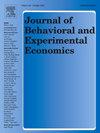Predicting prices of the US and G7 stock indices in uncertain times: Evidence from the application of a hybrid neural network
IF 1.4
3区 经济学
Q2 ECONOMICS
Journal of Behavioral and Experimental Economics
Pub Date : 2025-03-22
DOI:10.1016/j.socec.2025.102366
引用次数: 0
Abstract
This study investigates the application of Artificial Neural Networks (ANNs) to forecast the one-day-ahead closing price of the US and G7 indices, and makes an extended analysis of three distinct periods, namely, the pre-2008 financial crisis (2003–2007), post-crisis recovery (2009–2016), and recent economic uncertainty (2017–2022). Unlike the traditional predictive approaches, our model distinguishes itself by utilizing a hybrid ANN-based architecture that integrates variable selection and forecasting stages. The proposed model consists of two main parts: selecting relevant input variables and developing a forecasting model. In the first part, an ANN-based variable selection model is utilized to identify significant input variables based on historical market conditions that reflect economic and psychological influences over the study period. These inputs are then refined by eliminating variables with low contributions, resulting in improved model performance. In the second part, we evaluate the impact of different training algorithms, hidden layer sizes, and training data distributions on the ANN's forecasting accuracy. The findings demonstrate that ANNs can effectively forecast the S&P 500 index's and G7 indices’ prices with high accuracy, particularly when employing the Levenberg-Marquardt algorithm with a simplified model architecture. Moreover, the expanded dataset covering three distinct periods has enabled us to test the model's stability and generalization across diverse market volatility and structural conditions. The study highlights the critical role of data volume in enhancing the model's performance, confirming that extensive training data is essential for capturing the complex dynamics of market behavior.
在不确定时期预测美国和G7股票指数的价格:来自混合神经网络应用的证据
本研究调查了人工神经网络(ANN)在预测美国和七国集团指数前一日收盘价中的应用,并对三个不同时期进行了扩展分析,即 2008 年金融危机前(2003-2007 年)、危机后复苏(2009-2016 年)和近期经济不确定性(2017-2022 年)。与传统的预测方法不同,我们的模型采用基于混合 ANN 的架构,将变量选择和预测阶段整合在一起,从而与众不同。所提出的模型包括两个主要部分:选择相关输入变量和开发预测模型。在第一部分中,利用基于 ANN 的变量选择模型,根据历史市场条件确定重要的输入变量,这些条件反映了研究期间的经济和心理影响。然后,通过剔除贡献率低的变量来完善这些输入变量,从而提高模型性能。在第二部分,我们评估了不同训练算法、隐层大小和训练数据分布对 ANN 预测准确性的影响。研究结果表明,ANN 可以有效地预测 S&P 500 指数和 G7 指数的价格,尤其是在采用 Levenberg-Marquardt 算法和简化模型结构的情况下,预测准确率更高。此外,覆盖三个不同时期的扩展数据集使我们能够测试模型在不同市场波动和结构条件下的稳定性和泛化能力。这项研究强调了数据量在提高模型性能方面的关键作用,证实了广泛的训练数据对于捕捉市场行为的复杂动态至关重要。
本文章由计算机程序翻译,如有差异,请以英文原文为准。
求助全文
约1分钟内获得全文
求助全文
来源期刊
CiteScore
2.60
自引率
12.50%
发文量
113
审稿时长
83 days
期刊介绍:
The Journal of Behavioral and Experimental Economics (formerly the Journal of Socio-Economics) welcomes submissions that deal with various economic topics but also involve issues that are related to other social sciences, especially psychology, or use experimental methods of inquiry. Thus, contributions in behavioral economics, experimental economics, economic psychology, and judgment and decision making are especially welcome. The journal is open to different research methodologies, as long as they are relevant to the topic and employed rigorously. Possible methodologies include, for example, experiments, surveys, empirical work, theoretical models, meta-analyses, case studies, and simulation-based analyses. Literature reviews that integrate findings from many studies are also welcome, but they should synthesize the literature in a useful manner and provide substantial contribution beyond what the reader could get by simply reading the abstracts of the cited papers. In empirical work, it is important that the results are not only statistically significant but also economically significant. A high contribution-to-length ratio is expected from published articles and therefore papers should not be unnecessarily long, and short articles are welcome. Articles should be written in a manner that is intelligible to our generalist readership. Book reviews are generally solicited but occasionally unsolicited reviews will also be published. Contact the Book Review Editor for related inquiries.

 求助内容:
求助内容: 应助结果提醒方式:
应助结果提醒方式:


